How DP Linus Sandgren FSF used Kodak film to create an intimate portrait of an epic adventurer in 'First Man'
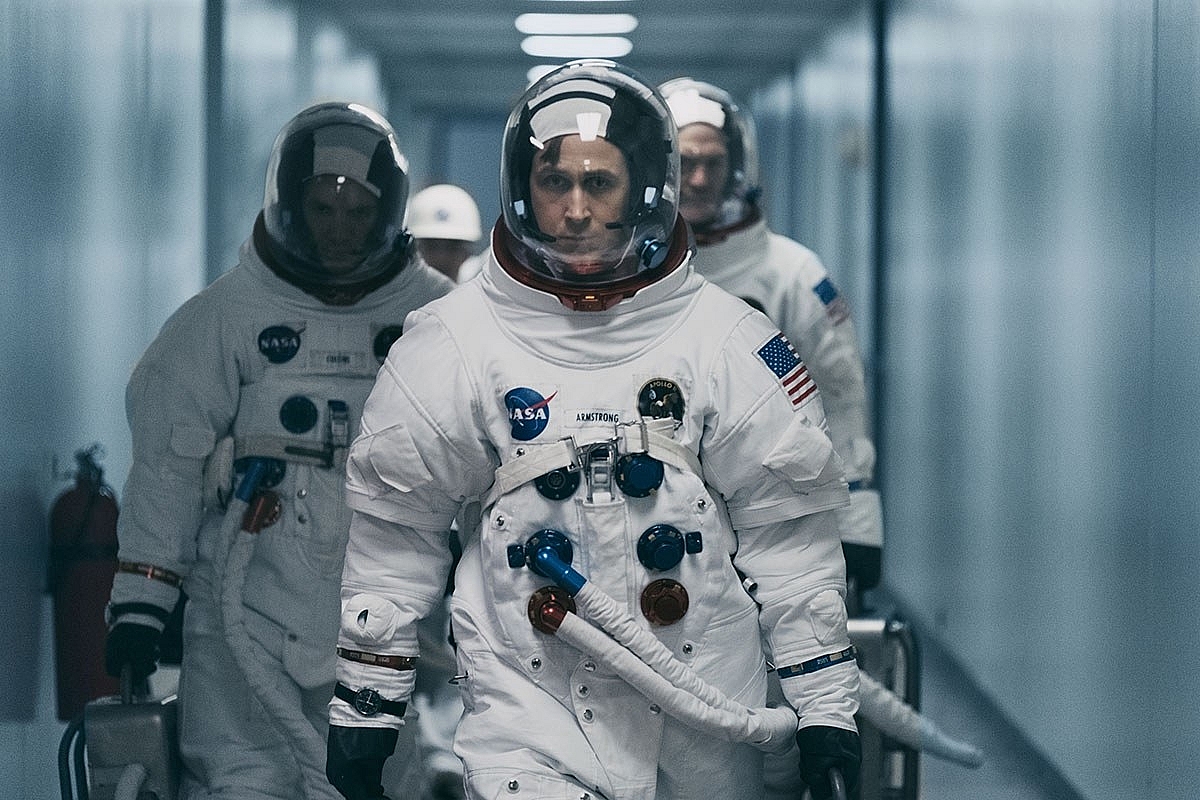
(L to R) LUKAS HAAS as Mike Collins, RYAN GOSLING as Neil Armstrong and COREY STOLL as Buzz Aldrin in "First Man", directed by Oscar®-winning filmmaker Damien Chazelle ("La La Land"). Credit: Daniel McFadden/Universal Pictures and DreamWorks Pictures
Created entirely on Kodak film in Super16mm, 35mm and IMAX formats, Damien Chazelle’s First Man has received critical praise worldwide – for its performances, cinematography, script, score, set design and direction – and looks set to feature strongly in the 2019 awards season.
Based on James R. Hansen’s book “First Man: The Life of Neil A. Armstrong” and written by Josh Singer, the Dreamworks/Univeral Pictures’ production follows the world’s most famous astronaut in the years leading up to the Apollo 11 mission and the successful moon landing on July 20, 1969. It stars Ryan Gosling as Neil Armstrong, alongside Claire Foy as Janet Shearon, Armstrong's first wife.
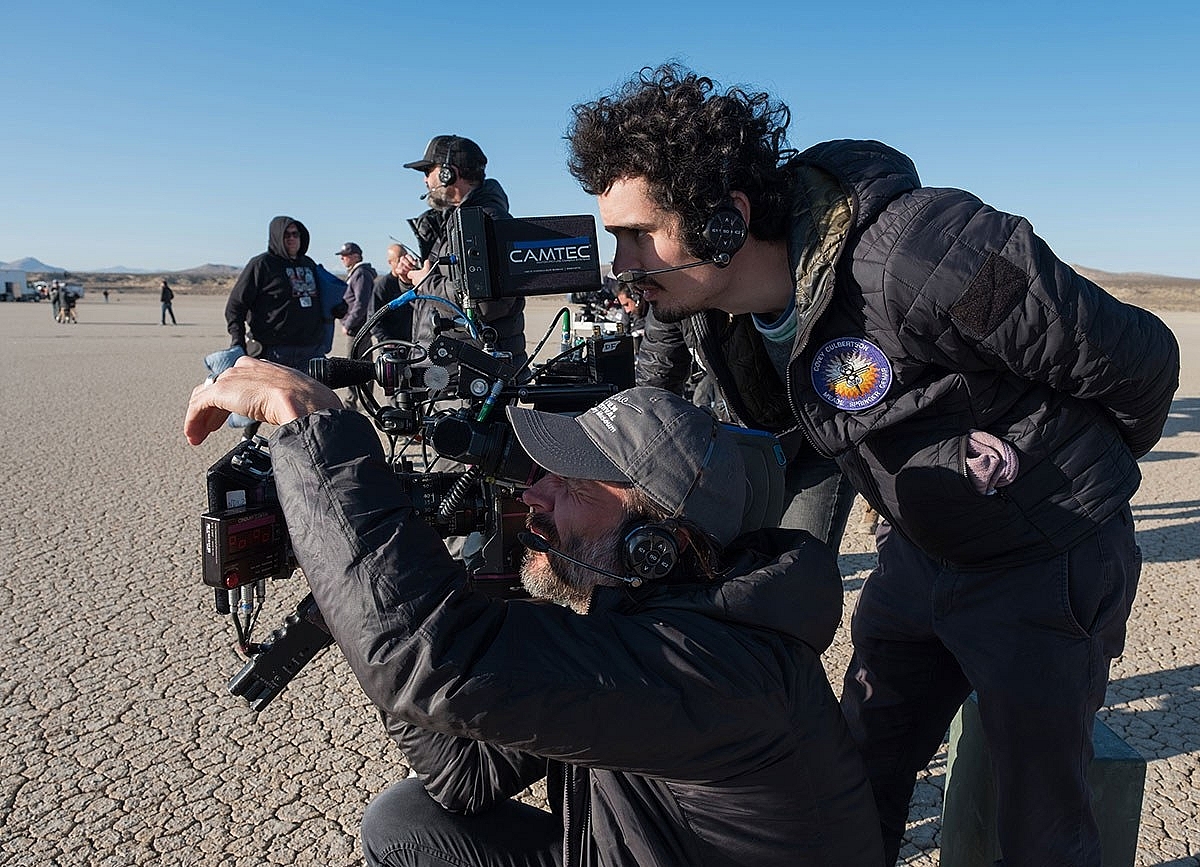
Oscar®-winning director DAMIEN CHAZELLE (right, standing) reteams with his Oscar®-winning Cinematographer LINUS SANDGREN ("La La Land") on the set of "First Man." Credit: Daniel McFadden/Universal Pictures and DreamWorks Pictures
First Man is the second cinematographic collaboration between Chazelle and cinematographer Linus Sandgren FSF, following their successful work together on La La Land, which was also shot on Kodak film. La La Land earned them both 2017 Academy Awards, amongst a total clutch of six Oscars for that production. Sandgren regularly shoots on film, with his 35mm celluloid credits including American Hustle (2013), Joy (2015) and Battle of the Sexes (2017). He shot Walt Disney Pictures’ forthcoming Nutcracker and the Four Realms (2018) and a music video featuring Paul McCartney, using 35mm and 65mm film formats.
First Man combines a personal focus on Armstrong – as both a family man and stoic astronaut-in-training – along with the soaring race to conquer spaceflight and to ultimately land a man on the moon. The films depicts Armstrong steadfastly working his way through NASA's formidable space programme, gamely testing the latest supersonic planes, while privately coming to terms with the grief of losing his daughter to a brain tumour. As such, the film explores a raft of human emotions, particularly courage and sacrifice in the face of inestimable adversity and mortal danger.
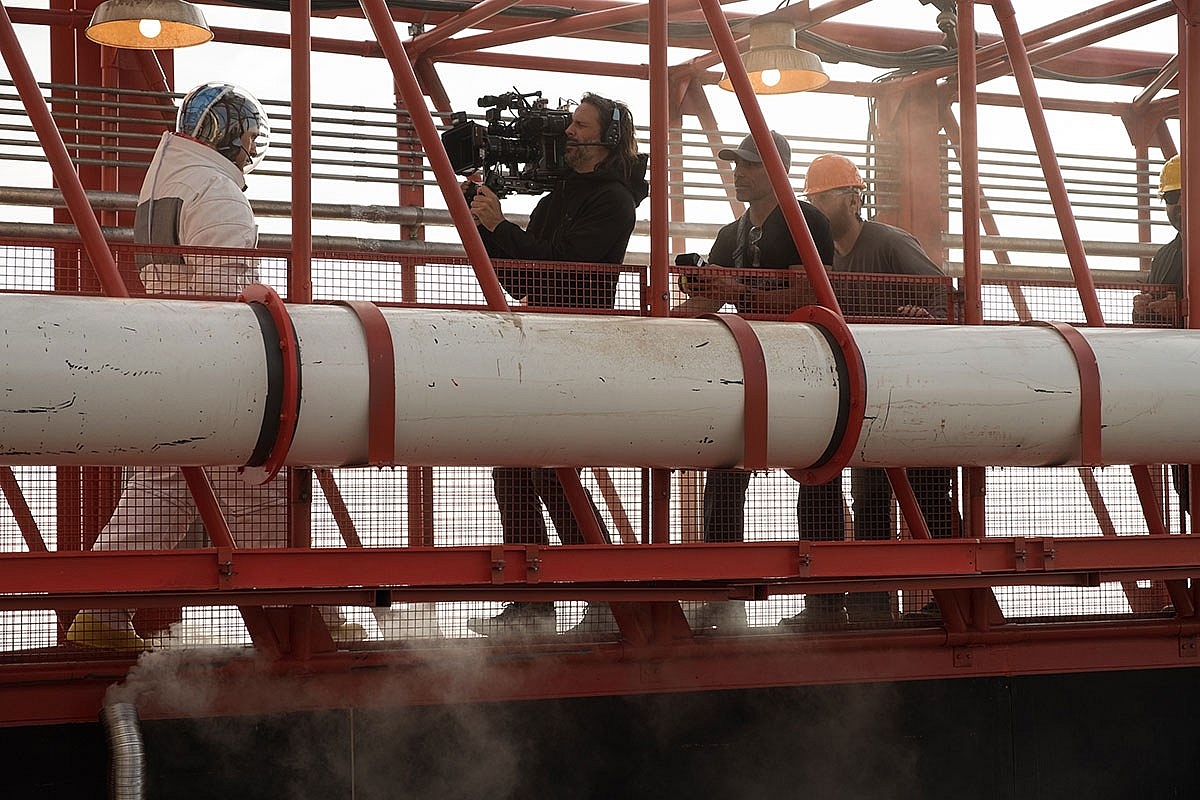
DP Linus Sandgren and crew capture the action in "First Man", directed by Oscar®-winning filmmaker Damien Chazelle ("La La Land"). Credit: Daniel McFadden/Universal Pictures and DreamWorks Pictures
“I initially heard about First Man when Damien and I were prepping La La Land in Los Angeles,” recalls Sandgren. “We stopped off at a taco truck in Venice and, quite by chance, bumped into Josh Singer. Damien introduced him to me as the writer of First Man, and that’s when I found out it would be our next movie together. Obviously, Damien and I were completely focused on La La Land, but I remember being really excited by the prospect of working on such a different type story with a different kind of vision.”
After riding the wave of acclaim for La La Land, Chazelle and Sandgren got down to serious prep and testing on First Man in July 2017. The movie went into production in October, with principal photography encompassing stage work at Tyler Perry Studios in Atlanta, locations around Atlanta and Houston, Texas, plus stints at The Kennedy Space Center, Cape Canaveral, Florida and Edwards Air Force Base, California. The production wrapped in March 2018.
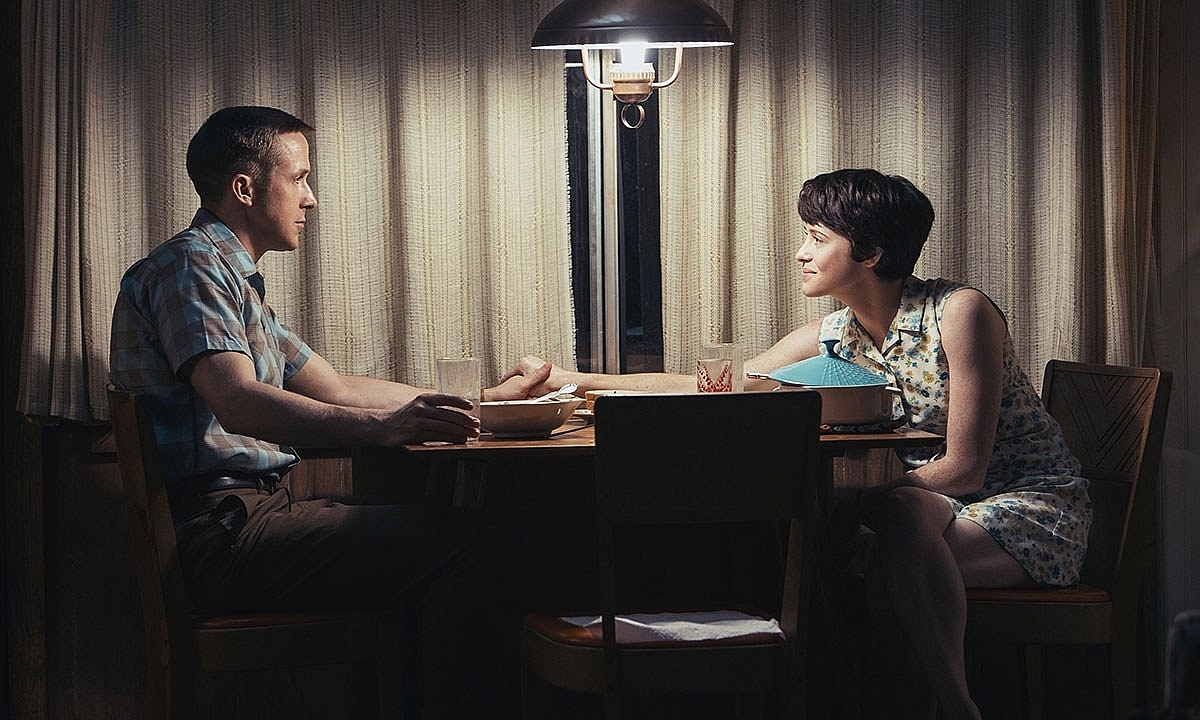
RYAN GOSLING as Neil Armstrong and CLAIRE FOY as Janet Armstrong in "First Man", directed by Oscar®-winning filmmaker Damien Chazelle ("La La Land"). Credit: Daniel McFadden/Universal Pictures and DreamWorks Pictures
“Damien was very clear from the start that First Man was going to be shot on film because of its inherent texture and the way that film, plus the set and costume design, automatically transport you back to a particular period in time,” says Sandgren. “Our initial thinking was to shoot it entirely on 16mm, as Damien was super-inspired by documentary footage from the time and wanted the audience to feel emotionally close to the characters.
“However, the more we kept testing and looking into the script, the more we saw the huge dramatic span of the story arc – from kitchen-sink realism in the home environment to the thrills of supersonic space trials, and then to the moon and the wider universe. Within this, we also wanted to explore the idea of individual bravery in the face of death – the Armstrongs’ tragic loss of their young daughter, the ongoing loss of Neil’s colleagues in pursuit of their various missions, and the ultimate death-defying feat of the lunar landing.”
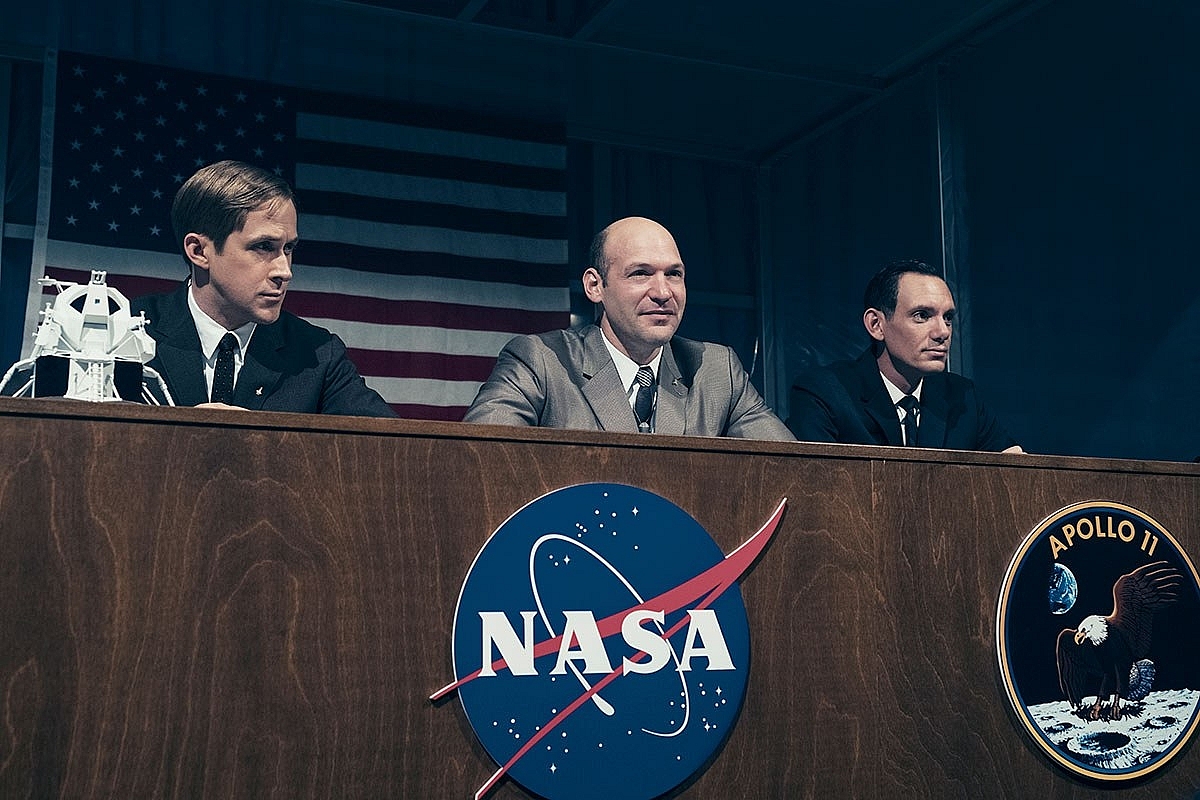
(L to R) RYAN GOSLING as Neil Armstrong, COREY STOLL as Buzz Aldrin and LUKAS HAAS as Mike Collins in "First Man", directed by Oscar®-winning filmmaker Damien Chazelle ("La La Land"). Credit: Daniel McFadden/Universal Pictures and DreamWorks Pictures
This led the pair to deploy a combination of Kodak film formats to depict the dynamism of the different events and emotions across the story arc – Super16mm, Super 35mm and IMAX 65mm (15-perf).
As Sandgren explains, “We chose to anchor the story back in time and to capture the most intimate and emotional scenes between the characters on Super 16mm. It’s inherent grain and grittiness is very pleasing, and it seemed perfect for that purpose. When the story moves into the various aircraft and spacecraft, we again felt the look needed to be intimate, real and raw.”
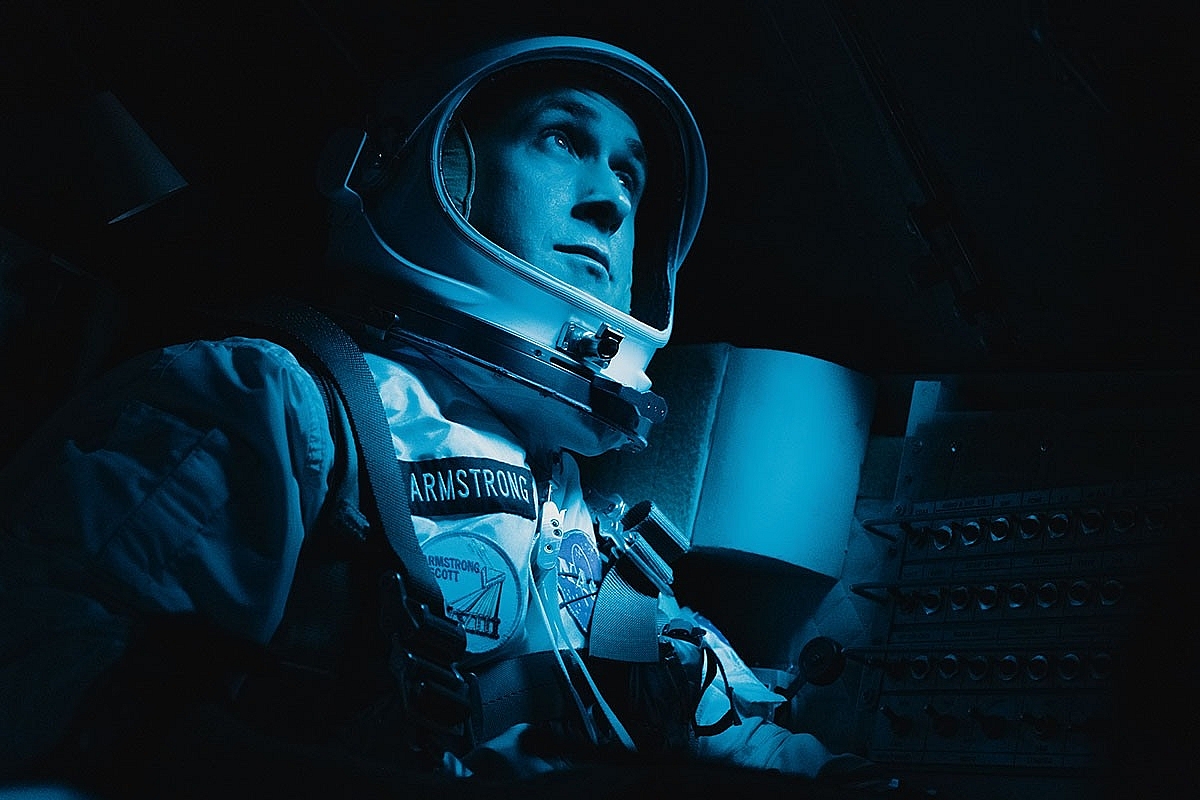
RYAN GOSLING as Neil Armstrong in "First Man", directed by Oscar®-winning filmmaker Damien Chazelle ("La La Land"). Credit: Daniel McFadden/Universal Pictures and DreamWorks Picture
Accordingly, the opening of the film, which depicts one of Armstrong’s harrowing X-15 sorties, and all shots within the tight confines of spacecraft interiors, were captured on Super16mm too, with tense and frequently frenetic handheld camera work. Sandgren used the full range of KODAK VISION3 Color Negative Film 16mm daylight and tungsten film stocks for these scenes.
Sandgren continues, “However, for bigger, wider shots, when the camera gets further away from the characters, such as the exterior scenes in the Houston suburbs and at NASA, we wanted more detail in the image but for the visual language to remain gritty and real. So we decided to switch to 2-perf Super 35mm Techniscope.”
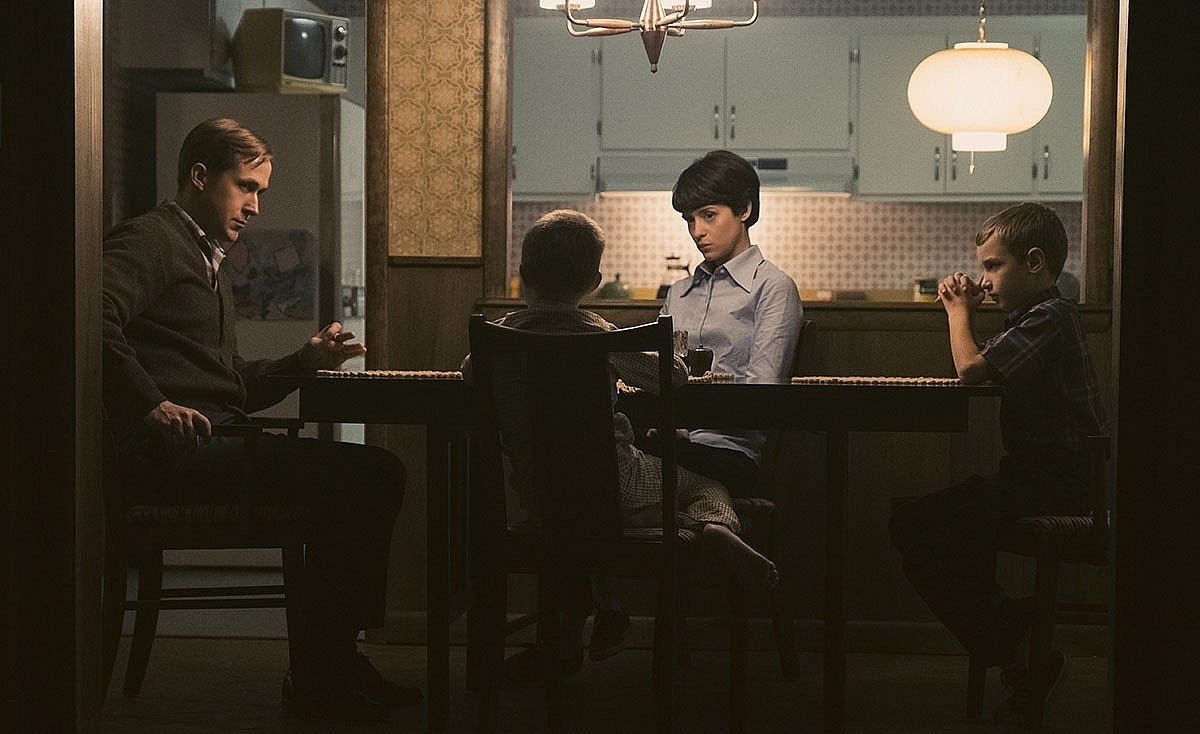
(L to R) RYAN GOSLING as Neil Armstrong, CONNOR BLODGETT as Mark Armstrong, CLAIRE FOY as Janet Armstrong and LUKE WINTERS as Rick Armstrong in "First Man", directed by Oscar®-winning filmmaker Damien Chazelle ("La La Land"). Credit: Daniel McFadden/Universal Pictures and DreamWorks Pictures
In practice, this typically saw Sandgren using KODAK VISION3 500T Color Negative Film 5219 and VISION3 250D Color Negative Film to create a softer look on what he calls “the pretense of the Armstrong’s good life in the suburbs” by pull-processing the 35mm footage at the lab. Conversely, he push-processed the 35mm 500T and 250D 35mm footage of the NASA environment to achieve a level of texture more akin to the Super16mm footage. “These visual treatments helped encourage the raw and beautiful textures of Nathan Crowley’s wonderful production design,” he adds. All film processing was done at Fotokem in Los Angeles.
To depict the dramatic lunar-landing and moon-walking sequences, and enter Armstrong’s anguished mind, entailed a rather different approach.

RYAN GOSLING as Neil Armstrong in "First Man", directed by Oscar®-winning filmmaker Damien Chazelle ("La La Land"). Credit: Daniel McFadden/Universal Pictures and DreamWorks Pictures
“When the story reaches the lunar surface, we wanted everything to change: from the familiar to the unfamiliar; from edgy, human, handheld 16mm camerawork, to sweeping crane shots of the un-human but serene environment; from colourful photography to stark and monochromatic imagery. We even wanted to change the audience’s point-of-view too – from watching and observing the astronauts, to becoming and feeling like astronauts themselves, especial Neil Armstrong. It was a golden opportunity for the visuals to contemplate on human mortality, and the loss and price involved in getting there.”
The solution for Chazelle and Sandgren was 65mm IMAX photography. This saw them filming the lunar surface sequences at night in the Vulcan granite quarry, a few miles north of Atlanta, lit by hugely-powerful 200K lamps specially developed for the film by David Pringle of Luminys Systems Corp.
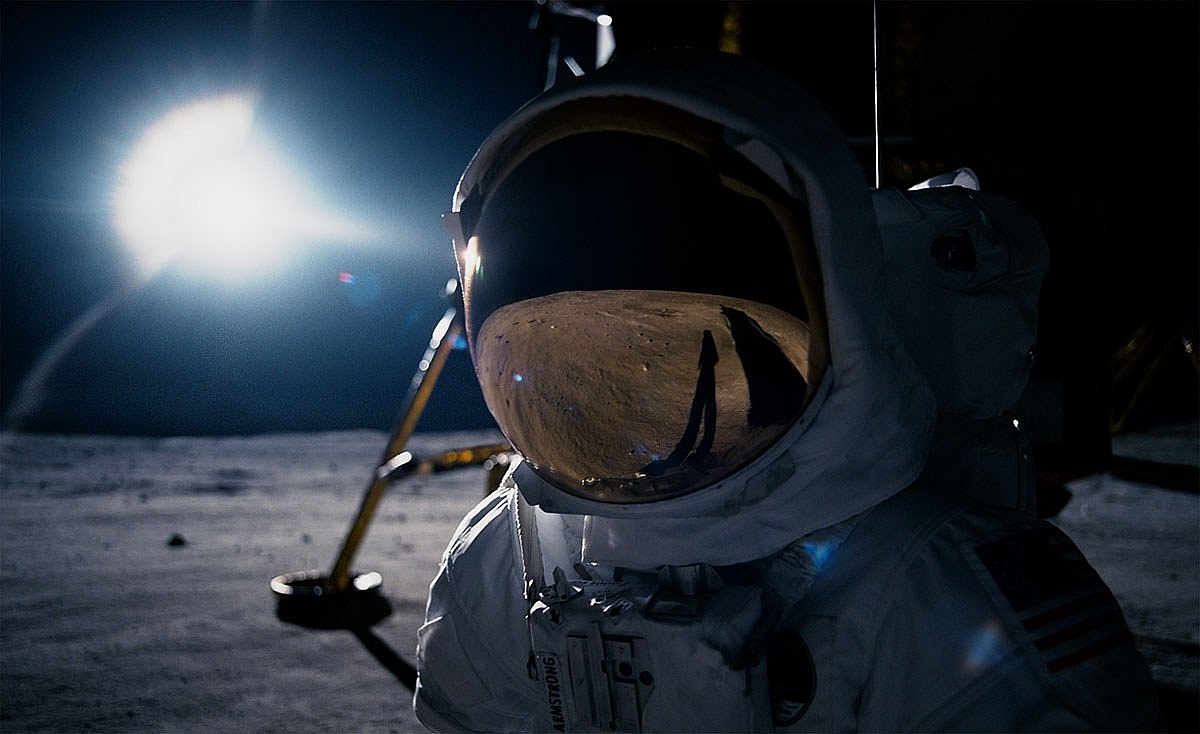
RYAN GOSLING as Neil Armstrong in "First Man", directed by Oscar®-winning filmmaker Damien Chazelle ("La La Land"). Credit: Universal Pictures and DreamWorks Pictures.
“The moon is a surreal world, like a planet of the dead, and there could be no better way to capture those iconic moments than by using the grandest, most beautiful film format of them all – IMAX 65mm,” says Sandgren. “It also made a complete contrast to the gritty Super16mm footage of interior of The Eagle lunar module. The moonscape was drained of color and because of the 15-perf film frame size, you see exquisite pictures with sharp details – such as light reflections from the sand crystals and superb details on the astronauts visors. With the camera floating on a crane, observing from Neil’s point-of-view, and the visuals set to Justin Hurwitz’s ethereal score, IMAX 65mm was the perfect way to express the climax of this personal journey.”
He notes, “If you are lucky enough to see First Man in an IMAX cinema, the visual experience of the frame opening out from widescreen Super16mm to IMAX 15-perf 65mm is pretty dramatic.”
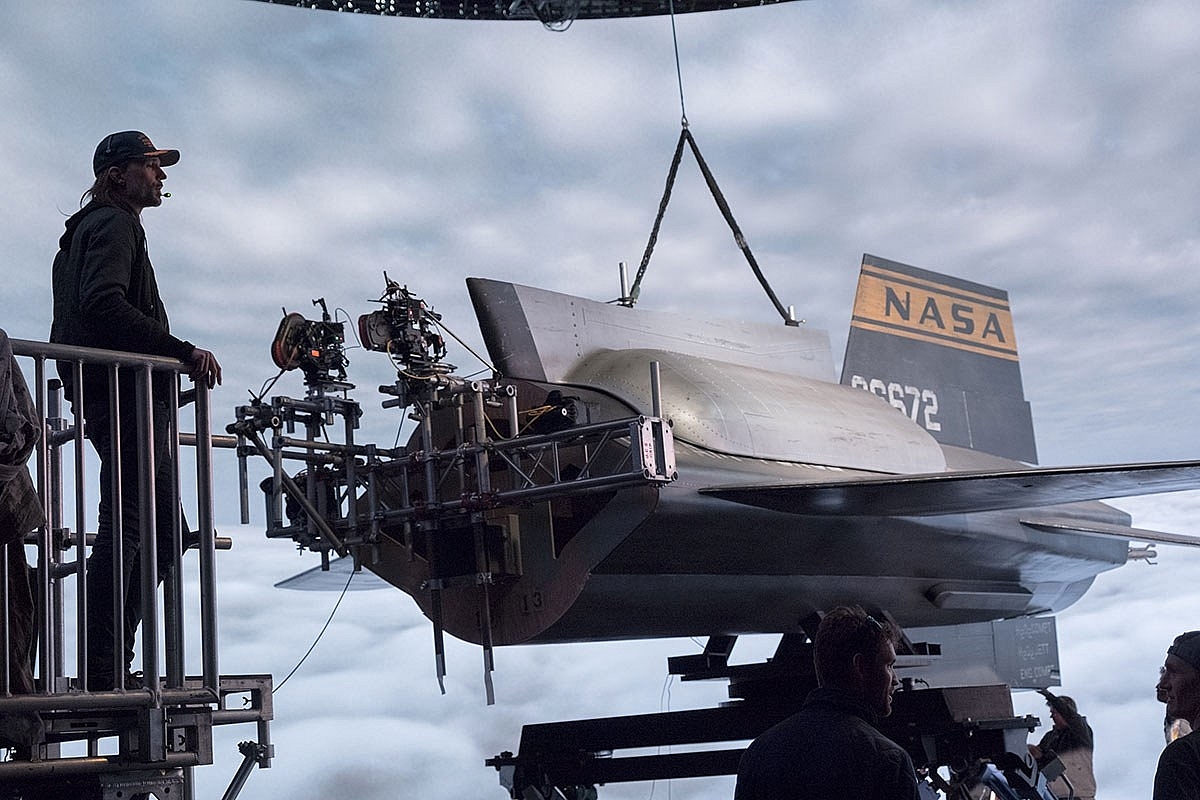
DP Linus Sandgren and crew on-set during production of "First Man", directed by Oscar®-winning filmmaker Damien Chazelle ("La La Land"). Credit: Daniel McFadden/Universal Pictures and DreamWorks Picture
Along with the use of multi-format film, Sandgren’s photography on First Man is also noteworthy in other respects. Special effects sequences – such as rocket launches – were created using a combination of real footage and scaled miniatures or life-sized models using VistaVision cameras. Additionally, many of the aerial and space scenes harnessed the use of enhanced environments to create realistic flight sequences. In practice, this saw around 1,000 LED screens with a 2.8mm pixel pitch, constructed in a half-cylindrical, 180-degree arc – some 35ft-high – displaying pre-shot, live-action background footage. The interiors of cockpits were then photographed on 16mm, and the craft exteriors on 35mm, against the convex curve of the LED screens.
“It was really exciting to combine some of the very latest on-set techniques with some of the oldest filmic tools,” says Sandgren. “The effect of using the enhanced environment was incredible. It gave the actors and the crew a real sense of a journey like no other, and the results look amazing, especially on 16mm.”
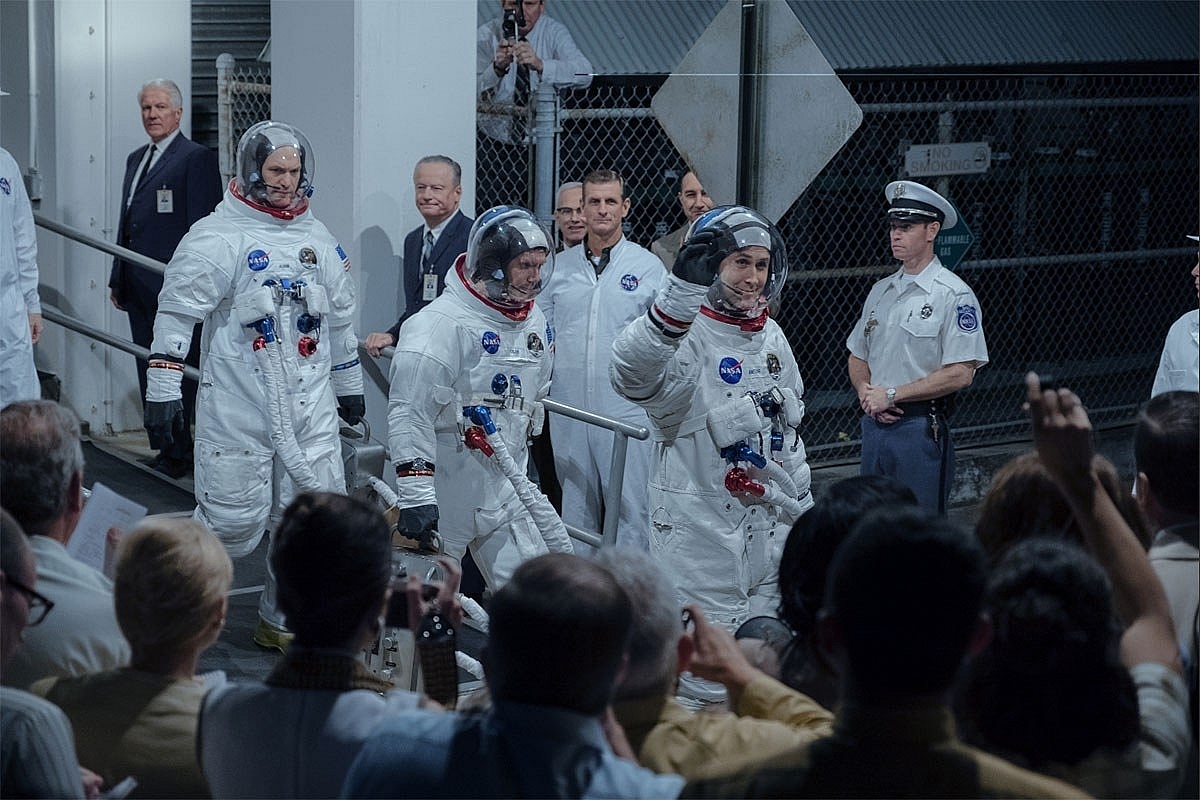
(L to R) COREY STOLL as Buzz Aldrin, LUKAS HAAS as Mike Collins and RYAN GOSLING as Neil Armstrong in "First Man", directed by Oscar®-winning filmmaker Damien Chazelle ("La La Land"). Credit: Daniel McFadden/Universal Pictures and DreamWorks Pictures
Sandgren concludes: “I am so grateful to have been able to use different film formats, and the variety of Kodak filmstocks, to help portray events and emotions in First Man. The quality of the highlights, depth of the blacks and faithful rendition of skin tones, goes without saying. You can make so many different looks so easily on film, and it’s just so much more expressive than digital.”
As a case in point, Sandgren also combined 65mm 5-perf and Super35mm 3-perf film for Disney’s fantasy adventure Nutcracker and the Four Realms, but that’s another story entirely. Stay tuned!